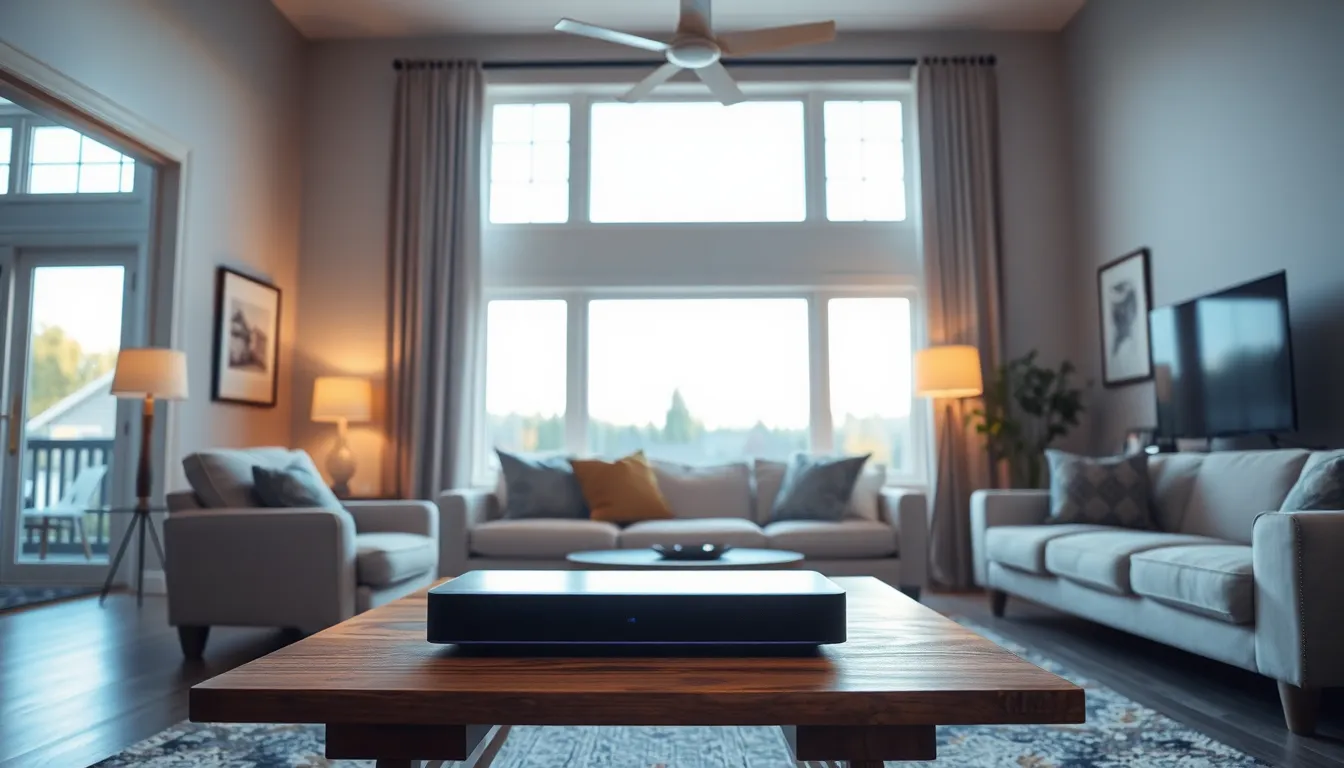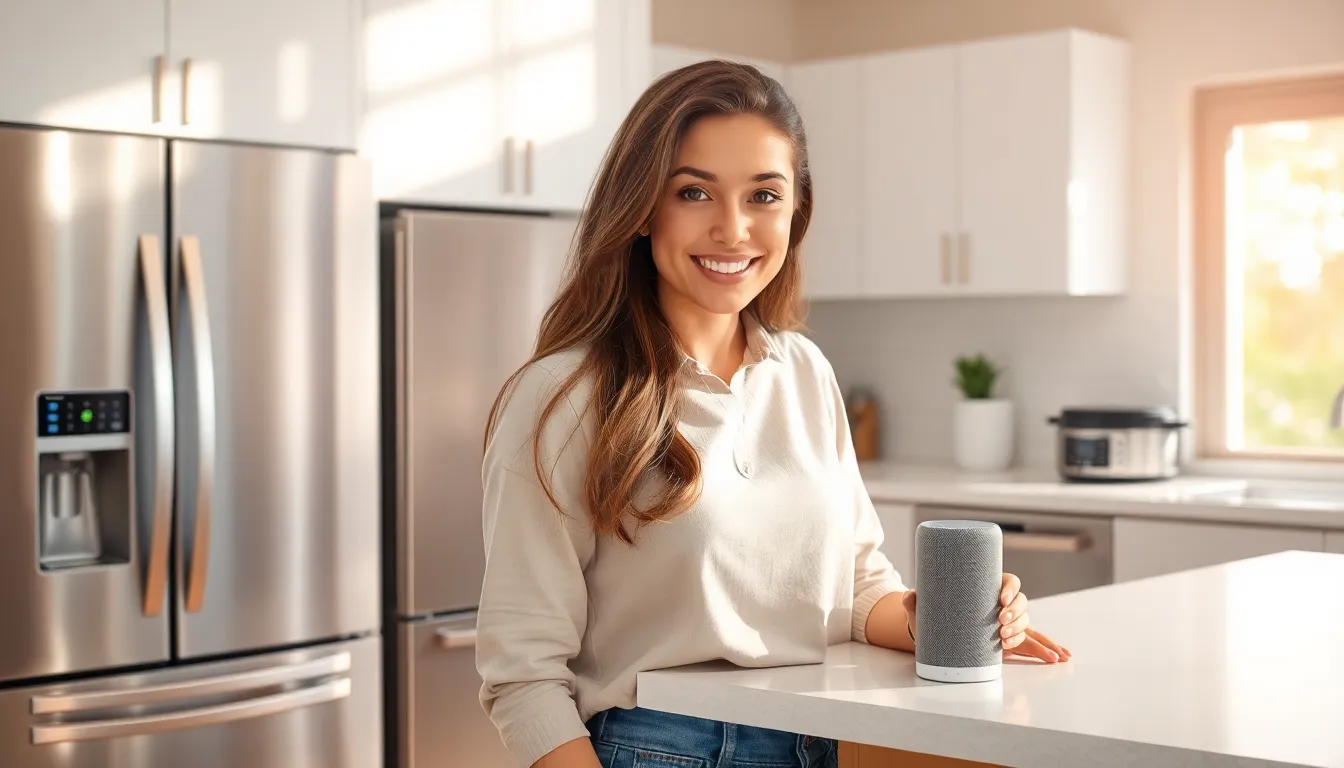Imagine waking up to the sound of your favorite tunes, the aroma of freshly brewed coffee filling the air, and your home adjusting the temperature just right—all without lifting a finger. That’s the magic of a smart home assistant. These nifty gadgets aren’t just tech toys; they’re your personal butlers, ready to tackle your to-do list and elevate your home experience.
From dimming the lights for movie night to ensuring your security system is armed, smart home assistants are the ultimate multitaskers. They make life easier, and let’s face it, who doesn’t want to feel like a wizard controlling their domain with just their voice? Dive into the world of smart home assistants and discover how they can transform your living space into a futuristic haven.
Table of Contents
ToggleOverview of Smart Home Assistants
Smart home assistants serve as central hubs for device management in modern homes. Capable of interfacing with various smart devices, they streamline control for users. Common functionalities include managing music playback, setting alarms, and adjusting lighting conditions.
Many of these assistants come equipped with voice recognition technology, allowing users to issue commands hands-free. Integration with popular platforms like Spotify and Netflix enhances entertainment options. Automation routines enable devices to perform tasks collectively, such as turning off lights or locking doors when leaving home.
Examples of leading smart home assistants include Amazon Alexa, Google Assistant, and Apple Siri. Each offers unique features tailored to different user needs. Compatibility also varies, with some assistants supporting a wide range of smart home products, while others focus on specific ecosystems.
Security features, like monitoring home cameras and sending alerts, add peace of mind for homeowners. Energy management tools help track consumption and optimize usage, contributing to sustainability efforts.
Users benefit from regular updates that enhance performance and add new features. The growing popularity of smart home assistants reflects a shift toward more automated living, making everyday tasks easier and more efficient. With continuous advancements, these devices remain pivotal in the evolution of home technology.
Key Features of Smart Home Assistants

Smart home assistants incorporate key functionalities that transform living spaces into efficient environments. They simplify interactions through advanced voice recognition and seamless integration with smart devices.
Voice Recognition Technology
Voice recognition technology enables hands-free operation, making life easier. Users can issue commands to their smart home assistants, controlling various functions with simple phrases. These assistants often boast advanced natural language processing, allowing for more conversational interactions. Commands like “play my favorite playlist” or “turn off the living room lights” typically execute quickly, improving the user experience. Accuracy in recognizing different accents and dialects enhances accessibility for diverse users. Regular updates ensure continual improvement in voice recognition, adapting to user speech patterns over time.
Integration with Smart Devices
Integration with smart devices centralizes control, simplifying management. Smart home assistants connect with various products, such as smart thermostats, security cameras, and lights. These integrations enable users to create customized routines, like setting the thermostat to a comfortable temperature before arriving home. Compatibility with platforms like IFTTT allows further expansion of functionality, automating daily tasks. Users benefit from streamlined interactions as they control multiple devices through one interface. Over time, this connectivity fosters a more energy-efficient and secure home environment.
Popular Smart Home Assistants
Numerous smart home assistants enhance daily living through their unique features and compatibility with various devices. Here’s a closer look at some leading options.
Amazon Alexa
Amazon Alexa stands out due to its wide compatibility. It integrates seamlessly with thousands of smart devices, allowing users to control lights, locks, and more through voice commands. With built-in features such as music playback, weather updates, and news briefings, it makes everyday tasks easier. Routines customize settings for morning and bedtime, elevating user experience. Regular software updates keep Alexa evolving, introducing new skills and improving functionality, which enhances its utility in homes.
Google Assistant
Google Assistant excels in voice recognition and conversational interactions. Users appreciate its ability to process natural language, making commands feel more fluid. Integration with Google services provides access to calendar reminders, search capabilities, and streaming. Smart home control extends to various devices with simple phrases, fostering a convenient lifestyle. Personalized responses cater to individual preferences, and daily routines streamline tasks effortlessly. Regular enhancements ensure Google Assistant remains a strong contender in the smart home market.
Apple HomeKit
Apple HomeKit focuses on privacy and security, appealing to users who prioritize these aspects. It offers an intuitive interface for managing smart devices across iOS platforms. Users can set up automation that activates devices based on specific triggers, like time or location. Siri, integrated with HomeKit, facilitates voice commands for device management. The Home app centralizes control, ensuring everything is organized and accessible. Additional features include robust encryption, enhancing user trust in its performance and capabilities.
Benefits of Using a Smart Home Assistant
Smart home assistants streamline everyday tasks and enhance the user experience. They provide convenience by automating processes such as adjusting thermostat settings and controlling lighting with simple voice commands. Increased energy efficiency results from automation, allowing users to manage power consumption more effectively.
Voice recognition technology contributes to hands-free operation, making it easier for users to interact with devices. Commands can vary from turning on music to setting reminders, empowering users to multitask efficiently. Connectivity with various smart devices fosters a harmonious living environment and centralizes control.
Enhanced security features, like real-time alerts and remote monitoring, offer peace of mind for homeowners. Smart home assistants can notify users of security breaches or unusual activity, ensuring a safer home. Regular software updates consistently improve performance and introduce new functionalities, adapting to evolving user needs.
Integration with popular platforms expands entertainment options and increases overall enjoyment. For example, streaming music from services like Spotify or controlling smart TVs enhances the media experience. Personalized routines allow for tailored living environments that cater to individual preferences.
Cost savings on energy bills result from effective management of appliances. Smart technology encourages users to optimize energy usage patterns, contributing to sustainability efforts. The ability to schedule devices to operate during off-peak hours can further reduce costs.
Overall, smart home assistants transform living spaces into efficient and enjoyable environments. Flexibility in device control, combined with robust technology, solidifies their role as essential tools in modern homes.
Potential Limitations and Challenges
Smart home assistants face several limitations that can impact user experience. Privacy concerns arise frequently, as these devices often collect personal data to improve functionality. Security vulnerabilities also exist, making devices potential targets for cyber attacks that could compromise user information.
Users sometimes encounter compatibility issues. Not all smart home products integrate seamlessly with every assistant. This lack of universal compatibility may frustrate users seeking to create a cohesive smart home environment.
Cost can serve as a barrier. Higher-priced smart assistants and compatible devices may deter some consumers. Although many entry-level options exist, their limited functionality can result in users feeling dissatisfied with their experiences.
Dependence on stable internet connectivity presents another challenge. Without a reliable connection, smart assistants experience interruptions, affecting their performance. Users may find themselves unable to access essential features during outages.
Limited voice recognition capabilities can present difficulties as well. Some users may struggle with accents or speech impairments, impacting the assistant’s responsiveness. A lack of understanding in these instances can lead to frustration and decreased satisfaction.
Lastly, ongoing maintenance and updates can create challenges for users. Regular software updates may disrupt functionality temporarily, leading to inconveniences. Users dependent on seamless operation might find these interruptions particularly bothersome.
Collectively, these limitations and challenges highlight the need for ongoing advancements in technology and user support within the smart home assistant landscape. Keeping these considerations in mind allows for informed decision-making regarding the implementation of smart home technology.
Smart home assistants have become indispensable tools in modern living. They not only simplify daily tasks but also enhance the overall home experience. With their ability to integrate various smart devices and provide hands-free control, these assistants create a more efficient and enjoyable environment.
As technology continues to evolve, the features and functionalities of smart home assistants will likely expand. Users can look forward to even greater convenience and security as these devices adapt to their needs. Embracing this technology can lead to a more connected and sustainable lifestyle, making smart home assistants an essential part of contemporary homes.








